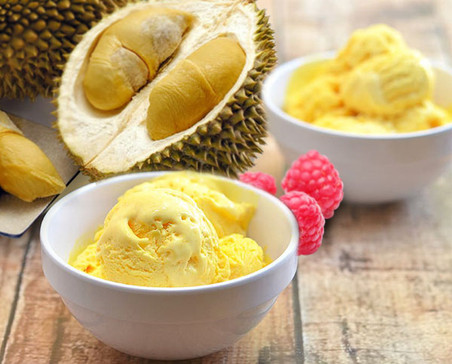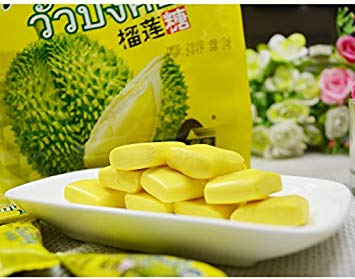Durian the King of Fruits
- Shane Peed
- Nov 8, 2020
- 6 min read
Durian is the fruit of several tree species belonging to the genus Durio. Many people in Southeast Asia call it the “king of fruits”. The word durian usually refers to the fruit but it can also mean the durian pulp or flesh (called arils) that we eat, and also to the tree.

Durian Botany
Durian is quite a big fruit with a very distinctive strong odor and formidable thorn-covered rind. The fruit can grow as large as 30 centimeters (12 in) long and 15 centimeters (6 in) in diameter. And it typically weighs one to three kilograms (2 to 7 lb.). Its shape ranges from oblong to round, the color of its husk green to brown. Its flesh pale yellow to red, depending on the species.
Durian Tree

Rain-forest is the natural environment for the durian tree which is tall, evergreen tropical tree with a straight trunk and buttressed base. A matured tree trunk can be 50-120 cm in diameter.
Durian Wood
Durian wood is classified as coarse and lightweight softwood. It is not durable and usually is used for making light furniture.
Durian Roots
Durian tree does not have root hairs. Instead, it has fungus roots that absorb water and nutrients. They grow only within 45 to 50 cm of the soil surface. Also, about 85% of the roots have the canopy radius of the tree. This is very useful in developing fertilizing and irrigation strategies for the durian.
Durian Leaf
Durian leaves are 10–20 cm long and 3-7.5 cm wide with a glossy olive or dull green smooth upper surface and velvety, shiny bronze lower surface due to the dense covering of overlapping hairs or scales. Also, the leaves change colour when the wind blows through the tree.

Durian Flowers
Durian flowers or their petals match the color of the edible flesh that will develop inside the fruit. Durian trees with yellowish flowers produce yellow-fleshed durians (the most common), while those with white or reddish petals will have white or reddish fleshed fruit.
Durian Seeds
Durian seeds are round or heart-shaped with yellow-brown or red-brown color depending on the cultivars. Durian seeds are poisonous when eaten raw but are very tasty when boiled, fried or roasted.
Durian Varieties
Over the centuries, numerous durian cultivars, propagated by vegetative clones, have arisen in southeast Asia. Most cultivars have a common name and a code number starting with "D". For example, some popular clones are Sultan (D24), Kop (D99), Chanee (D123), Kan Yao (D158), Mon Thong (D159), and with no common name, D169. Each cultivar has a distinct taste and odour.
Mon Thong is the most commercially sought for its thick, full-bodied creamy and mild sweet-tasting flesh with relatively moderate smell emitted and smaller seeds, while Chanee is the best in terms of its resistance to infection by Phytophthora palmivora. Kan Yao is somewhat less common, but prized for its longer window of time when it is both sweet and odourless at the same time.

Durian Environment
In South East Asia where the durian is "The King of Fruits", the durian production season is greatly influence by the north-east and south-west monsoons. The dry weather in between the monsoons usually happens in the middle of the year around June-July.
Soil
Durian prefers deep, well-drained soil with pH about 5.0-6.5. It grows very well on slopes and foothills. Durian does not perform well if elevation is higher than 600-900m above sea level, if there are waterlogged conditions and is vulnerable to wind damage during storms and typhoons.
Temperature
Since durian is native to the tropics, it needs a hot environment (24-32°C) and moist (75-80% humidity). It will not grow when daily temperature drops below 22°C.
Rainfall
Durian requires an annual rainfall of about 1500mm. Because the durian root system is very shallow (< 30cm), supplementary irrigation is very necessary for all stages of plant growth.
Dry Weather
When matured, durian requires about 1 to 2 months of dry environment for flowers to initiate and develop. 4 weeks after the flowers bloomed, the tree needs water for proper fruit development. Too much water will cause the tree to bear new leaves at the expense of the fruits. Not enough water will prolong fruit ripening to the rainy season.
Irrigation
Young durian trees are very susceptible to drought and high mortality can be avoided with proper irrigation. Trees that received irrigation are more vigorous and will begin to bear fruits much earlier - usually at 5-6 years.

Establishing A Durian Orchard
First thing you have to know before you decide to establish a durian orchard is that it takes 5-6 years (sometimes longer) before you can harvest your first fruits. There are many insects, pests, fungal diseases and disorders that attack durian causing serious damage to the tree. So here is a guideline for successful establishing of the durian orchard:
Site Location
It’s important to consider the location of your site. Many countries have maps showing agro-ecological regions where the effects of climate and soils on agricultural production of certain crops are generalized and recommendations for the most suitable crop or crops are given. If there is a history of previously successful durian growth - it’s a very good sign.
Land Preparation
The most suitable method of preparing your land for durian planting depends on your farm size, topography and planting system.
Large and flat farms require big equipment though keep in mind the soil compaction caused by this method.
Small and hilly farms do not require much equipment usage. Tree trunks or stumps are generally left to rot but if they are diseased or termite-infested, appropriate action must be taken to prevent its spread.
Legume Cover Crops

Durian farmers often grow cover crops to prevent soil erosion, to improve or maintain the soil structure and fertility, to suppress weeds, to prevent rapid loss of water from the soil through evaporation, and to keep the soil temperature down during hot weather.
Leguminous plants are usually used as a living mulch. They are usually seeded after land clearing, they grow fast and cover the entire area of the farm within two years. Cover crop seeds or planting materials must be of high quality and free from pathogens to avoid failure through low quality seeds.
Irrigation system
Water is very critical during planting in the field as young durian trees are very susceptible to drought and mortality can be as high as 50%. Insufficient water can also weaken the plants and make them more vulnerable towards pests and diseases.
Many farmers use the irrigation system not only to supply water but to deliver plant nutrients, supplements and chemicals directly to the durian trees. A stream with a regular flow of water even in the dry months or a well with high water table are excellent features for a durian orchard.
Durian Production Stages
Durian production technologies have been developed based upon an understanding of several factors and concepts such as the crop itself (durian), necessary production materials, environmental requirement and agronomy. In general, one production cycle has 5 main development stages:

1. Harvesting
Depending on the durian cultivars, the fruits will mature and drop 3-5 months after flowering. Natural fruit drop usually last about 10 weeks peaking in the second and third week and decreasing in the later weeks. The durian trees must be pruned to promote the emergence of new shoots and fertilized with NPK fertilizers to prepare the trees for healthy growth.
2. Leaf Growth Stage
After harvesting you will see new leaves appear on the tree. If the development of new leaves is poor, it is advisable to increase the nitrogen applied to the soil, as well as in the foliar sprays. Also, irrigating the trees frequently supports the development of new leaves.

3. Tree Preparation
At this stage it is important to keep your trees in check, including the irrigation, pests and diseases that can appear and affect the durian growth and development. Two months before flowering apply fertilizers to help existing leaves to mature; prevent the appearance of new leaves to avoid competition for nutrients; enhance flower initiation.
4. Flowering Stage
Water is a key factor on this stage as it controls how good the flowering goes. Reduce water when flowers open even if you are experiencing strong wind in your area. Check for pests and if needed - apply PPP. Before flowers start to open - reduce watering to one-third of normal supply.
After that increase water to correlate with fruit growth. Then do durian pollination using pollen from different varieties or from the same variety but different trees. Adding a foliar application during this stage and impact the yield and overall quality of the fruit during harvest.
5. Fruit Growth Stage
Durian fruit development takes about 95–130 days after pollination depending on the varieties or cultivars. Fruit ripening usually takes place in the end of the dry season - in the beginning of the rainy season. To improve the size and general quality of the fruit, fertilizer should be applied both to the soil and in the form of a foliar spray. In the end you should get large fruit (between 2 and 5 kg) ready to be harvested!
Durian Pests & Diseases
Most common durian diseases:
Leaf Spot
Fruit Rot
Seedling Die-back
Canker
Most common durian pests:
Bark Beetles
Fruit and Stem Borers
Termites
Most common durian disorders:
Uneven Fruit Ripening
Wet Core
Tip Burn
Durian Usage
The durian flesh typically comprise 15–35% of the fruit weight, and is composed of about 2.5% protein, 2.5% fat, 28% carbohydrate and 67% water, with smaller amounts of fiber, minerals and vitamins.
Durian fruit is good to flavor a wide variety of sweet edibles such as traditional candy, rose biscuits, ice cream, milkshakes, mooncakes, and cappuccino. Dried durian flesh is popular for durian chips. You can also cook unripe durians as a vegetable, except in the Philippines, where all uses are sweet rather than savory.
Don’t forget yummy Durian ice cream when visiting areas where this fruit grows!























